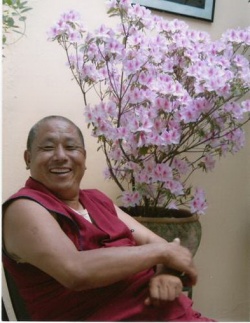The Four Sections of Tantra & the Four Types of Practitioners
The four sections of Tantra, rgyüd-sde-bzhi in Tibetan, are:
1) & 2) Kriya Tantra and Charya Tantra (the Sanskrit terms that were translated into Tibetan as spyöd-rgyüd and bya-rgyüd respectively) emphasize outer purification of body and speech and of disturbing emotions. Practitioners learn to become less involved with worldly activities and concentrate on attaining inner tranquillity in order to be able to roughly experience emptiness, which is the purpose of practice.
3) Yoga Tantra (translated into Tibetan as rnäl-‘byor-rgyüd) is the third Tantra. More advanced students who engage in Yoga Tantra practice focusing their attention one-pointedly on emptiness.
4) The fourth Tantra, Anuttara Yoga Tanta (bla-med-rnäl-‘byor-rgyüd) is supreme. Very advanced meditators of Anuttara Yoga focus their attention on merging Bodhicitta and primordial wisdom-awareness until they become indivisibly united in their mind-stream.
Lord Buddha taught the four Tantras because students have varying propensities and abilities. It is not the case that one single practice is applicable for everyone since everyone is different. Now, people can be classified into four types, also referred to as “four enlightened families,” rigs-bzhi in Tibetan.
1) There are individuals in society who are said to belong to the priestly Brahman caste (bram-ze in Tibetan). They concentrate their attention on outer practices through ritual cleansing to purify their body and on recitation of mantras to purify their speech, which correspond to practicing the first Tantra, Kriya Yoga.
2) There are other individuals in society who belong to the warrior or royal Ksatryia caste (rgyäl-rigs in Tibetan). They concentrate their attention on spreading the Dharma by speaking about it to others with their speech or by painting Thankas with their hands for others to see, which corresponds to practicing the second Tantra, Charya Tantra.
3) Those individuals who are said to belong to the Vaisya caste (rje’u-rigs) are traditionally seen as merchants or tradesmen. Although lower in status according to the caste system, they are so advanced that they need not engage in many outer rituals anymore and can abide within the nature of the mind without exerting much effort, the reason they belong to the Buddha family. Their practice corresponds to Yoga Tantra.
4) Individuals belonging to the Sudra caste (dmangs-rigs) are those who usually work as servants or labourers. They are those persons who are seen to belong to the lowest category in the traditional caste system, but as practitioners they do not engage in any outer rituals anymore. They do not practice austerity or carry out cleansing rituals since they have fully turned their minds inwards. Their practice corresponds to Anuttara Yoga Tantra.
Seeing that there are four types of practitioners, the Buddha taught the four Tantras - the Kriya, Charya, Yoga, and Anuttara Yoga Tantras. Where can we start practicing? Lord Buddha offered three stages of teachings to students who wish to begin practicing.
